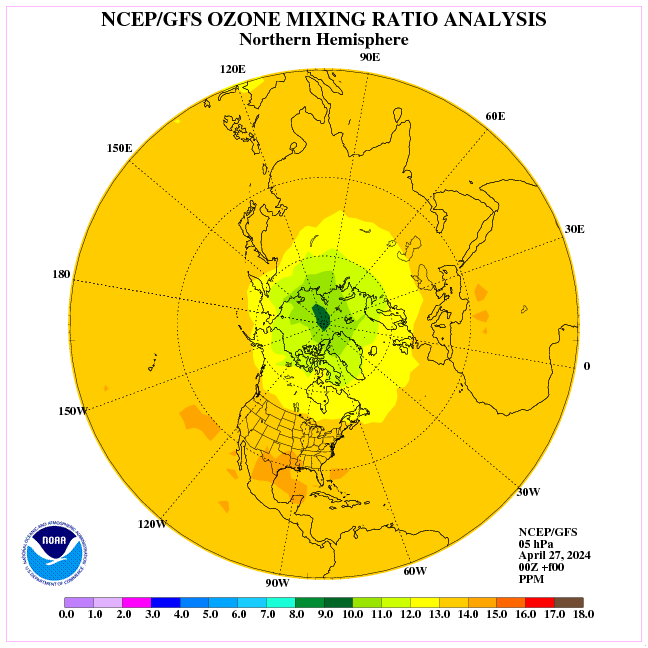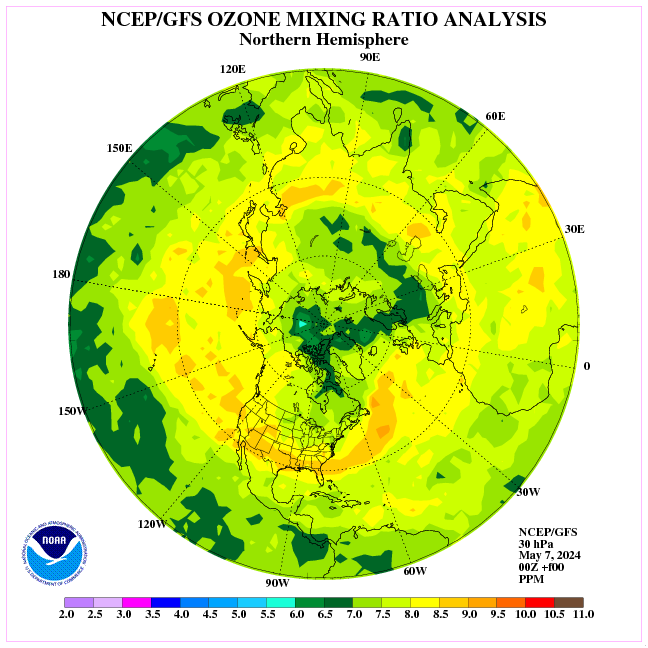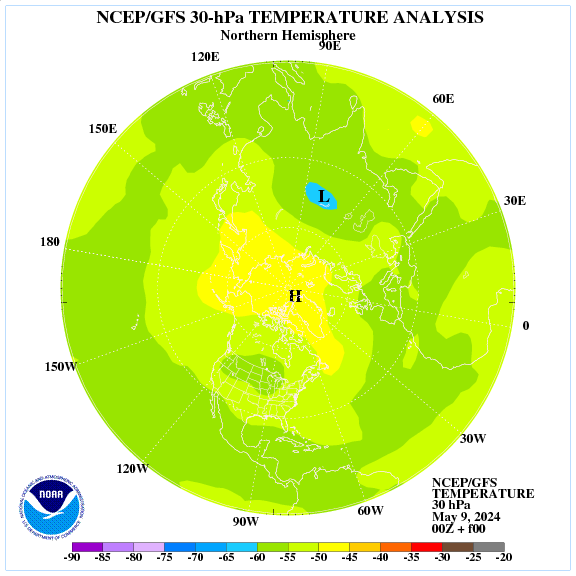The authors write in this plain language summary:
Changes in the output of the Sun are thought to influence surface weather and climate through a set of processes initiated by the enhancement of upper stratosphere (32‐48 km) ozone. In order to understand and assess the solar impact on the climate system, it is important that models reproduce the observed solar signal. However, the recommended dataset for comparison with climate models remains disputed.
We use newly improved observed ozone composites to determine both why there is disagreement between composites, and which is most likely to be correct. We find that artefact‐corrected composites represent the response better than those based on SBUV data alone. Further, we identify a U‐shaped spatial structure with lobes emanating from the tropics to high altitudes at mid‐latitudes.
An idealised chemistry climate model experiment, and simulations considering historical meteorological conditions, both support this conclusion. The results are of benefit to satellite‐instrument scientists, and to those engaged in atmospheric and climate research using both observations and climate models.
The results will be important for assessing the solar signal in currently active and future assessments of chemistry climate models (e.g. CCMI). We recommend recommend the BASICv2 ozone composite to best represent historical upper stratospheric variability.
The paper:
The upper stratospheric solar cycle ozone response
W. T. Ball E. Rozanov J. Alsing D. R. Marsh F. Tummon D. J. Mortlock D. E. Kinnison J. D. Haigh
First published: 31 January 2019, Geophysical Research Letters
https://doi.org/10.1029/2018GL081501
Abstract
The solar cycle (SC) stratospheric ozone response is thought to influence surface weather and climate. To understand the chain of processes and ensure climate models adequately represent them, it is important to detect and quantify an accurate SC ozone response from observations. Chemistry climate models (CCMs) and observations display a range of upper stratosphere (1–10 hPa) zonally averaged spatial responses; this and the recommended dataset for comparison remains disputed. Recent data‐merging advancements have led to more robust observational data. Using these data, we show that the observed SC signal exhibits an upper stratosphere U‐shaped spatial structure with lobes emanating from the tropics (5–10 hPa) to high altitudes at mid‐latitudes (1–3 hPa). We confirm this using two independent CCMs in specified dynamics mode and an idealised timeslice experiment. We recommend the BASICv2 ozone composite to best represent historical upper stratospheric solar variability, and that those based on SBUV alone should not be used.
That’s what I’m talkiing about!
“John Tillman February 3, 2019 at 3:28 pm
“TSI is less climatically significant than the variation in its UV component, which is about two orders of magnitude greater than in TSI, and qualitatively different from visible and IR spectra, thanks to its effect on ozone and its penetration of seawater, among other factors.”
A sadly rare instance of actual climatological science being practiced amid the dreck of GIGO computer gamed “climate science”.
‘The solar cycle (SC) stratospheric ozone response is thought to influence surface weather and climate.’
Dr. Svalgaard will not like that one bit.
He might be right though, ‘is thought’ is not same as ‘it does’ we need to see proof !
A proposed chemistry, electron transport mechanism and effect of ozone is contained in Prof Qing-Bin Lu’s book:
“My work on atmospheric ozone depletion and global climate change has been well documented in the following book published in 2015:
QB Lu, A monograph “New Theories and Predictions of the Ozone Hole and Climate Change”, World Scientific Publishing Co (July, 2015), ISBN-10: 9814619442, 308 pages.
https://www.amazon.com/Theories-Predictions-Ozone-Climate-Change/dp/9814619442 .
The above paper can be seen as adding to the material supporting Prof Lu’s hypothesis. In-lab atmospheric chemistry experiments replicated the proposed mechanism. His published papers describe the mechanism and show the satellite data sets used to demonstrate the predictions are correct. This paper updates and tends to confirm which data set(s) are most helpful for understanding the mechanisms.
Once again we need to look at the effect of volcanoes on stratsphere / ozone.
https://climategrog.wordpress.com/uah_tls_365d/
It would helpful to have access to the paper to see what datasets they “prefer” ( ie best fit their hypothesis ). The trouble is the fullest data comes from the satellite period and those two stratospheric eruptions were quite close to two solar cycle peaks. There is a strong possibility of false attribution.
At least if they are looking at ozone they may be one step close to realising the effect vulcanism has on the stratosphere …. and one day they may be get down working out they do not just have a short term cooling effect.
Science doesn’t do “proof”, just confirmation and falsification of predictions made upon hypotheses.
There is lots of evidence for the effects of ozone on climatic phenomena, observed for decades.
https://www.giss.nasa.gov/research/features/200402_tango/
I said : “we need to see proof !”
Science observes, in this case climate events and takes note of the parameters involved, compiles data, repeating on number of occasions and if recorded observations agree with the premise of the hypothesis it can be said that ‘we have seen the proof’; hypothesis is accepted as correct and even may qualify as a theory.
I thought it was obvious what I meant, but if wasn’t now it should be clear.
Look, Leif says that the sun has no influence on the earth’s climate.
And that’s good enough for me.
Charles,
Do I detect sarcasm in your comment?
TSI is less climatically significant than the variation in its UV component, which is about two orders of magnitude greater than in TSI
The UV energy component is smaller than the combined energy from visible light and infrared wavelengths, therefore full TSI has a much greater ocean climatic significance than UV. High UV index over land is climatically significant, most effective at land warming under cloudless skies, a condition brought about often by low TSI low tropical evaporation. Solar minimum conditions lead to dry hot land temperatures for this very reason, while extended solar maximum high TSI eventually yields warm wet El Nino conditions released from higher solar energy accumulation.
http://gakuran.com/eng/wp-content/uploads/2008/03/light_penetration_ocean.jpg
http://geologycafe.com/oceans/images/insolation_curve.jpg
The models say the Earth will be hotter than the Sun by 2100 or so. They’re always right,doncha know!
The CMIP5 models ran hot out to 2100 partly because they were originally based on an unrealistic solar forcing in RCP8.5 CMIP6 employs a wider variety of solar forcing scenarios. But then you’re still back to trusting models based on CO2 warming theory.
What are “recent data merging advancements”? Is this anything like Mikey’s Trick?
While the Ball, et al. GRL paper is paywalled, this recent one on merging relevant data sets isn’t:
https://www.researchgate.net/publication/292188312_The_representation_of_solar_cycle_signals_in_stratospheric_ozone_-_Part_1_A_comparison_of_satellite_observations
Hope it helps answer your question.
And if you don’t think the stratosphere plays a major part on air temperatures on the ground, just take a look at what the recent strat warm event did to temperatures in Chicago and Minneapolis. While the event was essentially transient, a lot of Telsas didn’t make it out of the garage for quite a few days.
The real question is how all this couples into global ocean temperatures, since almost all the captured solar energy is in the oceans, and the keyword is ALL. Unfortunately we humans are short lived compared to seeing the results of the heating and cooling of the oceans. One low or high solar cycle can’t be seen in the temperature records, but put 6 in a row and we may start to see a change. But at 11 years per cycle we are nearing a human lifetime and in the meantime the chicken littles are modeling the noise with not that much success.
It might make sense if it can be shown that polar vortex is made out of ionised ozone (O3) molecules.
If so a major enigma of January sudden cold snap is easily resolved.
I recall Solar cyclic variability can modulate winter Arctic climate
Thermosphere Climate Index found on spaceweather.com
Dr. Indrani Roy on Solar and Climate Cycles
http://exp-studies.tor.ec.gc.ca/cgi-bin/selectMap?lang=e&type1=du&day1=30&month1=01&year1=2019&howmany1=1&interval1=1&intervalunit1=d&hem1=n&type2=no&day2=03&month2=02&year2=2019&howmany2=1&interval2=1&intervalunit2=d&hem2=n&mapsize=100
NH ozone map for Jan 30 2018
oops meant Jan 30 2019
There you go:
“Whilst changes in total solar irradiance (TSI) between the maximum and minimum5phases of the approximately 11 year solar cycle are known to be small (6%) (e.g. Ermolli et al.,2013). An increase in UV irradiance impacts stratospheric heating rates, and thustemperatures, through two main mechanisms: (1) enhanced absorption of radiation by ozone, and (2) enhanced production of ozone through the photolysis of oxygen at10 wavelengths less than ∼242nm. Consistent with these mechanisms, past studies us-ing models, reanalysis data and observations have identified an increase in annualmean temperature in the upper stratosphere of up to ∼1.5 K between solar maximumand minimum (e.g. Ramaswamy et al., 2001; Austin et al., 2008; Mitchell et al., 2015a),and an increase in ozone abundances of a few percent (Haigh, 1994; Soukharev and15Hood, 2006). These radiative changes modify the meridional temperature gradients inthe upper stratosphere, which can lead to a modulation of planetary wave propagationand breaking, and changes in the strength of the stratospheric polar vortex (e.g. Kurodaand Kodera, 2002; Matthes et al., 2004, 2006; Gray et al., 2010; Ineson et al., 2011).Such feedback mechanisms can lead to amplified changes in regional surface climate20via stratosphere–troposphere dynamical coupling (e.g. Gray et al., 2010). Constrain-ing the stratospheric temperature response to solar forcing is therefore important forunderstanding solar–climate coupling and sources of decadal variability in the climatesystem (e.g. Thiéblemont et al., 2015)”
https://www.researchgate.net/publication/292188312_The_representation_of_solar_cycle_signals_in_stratospheric_ozone_-_Part_1_A_comparison_of_satellite_observations
Can I have my Freon back now?
Yep, it was El Chichon and Mt Pinatubo that were the cause of the later 20th c. reduction in ozone. That Montreal protocol magically fixed by preventing any more volcanoes from erupting.
The fire in Grenfeld Tower would not have a happened if we had not stupidly started using inflamable gases in place of CFCs.
Many very useful chemical products have been banned on the basis of false attribution.
From the article: “In order to understand and assess the solar impact on the climate system, it is important that models reproduce the observed solar signal.”
Uhhhh . . . since when has the 97% consensus of AGW-confirmed climate scientists ever believed that?
It
The Times headline:
‘Crocodiles roam streets of Townsville, Queensland after ‘once in a century’ flood in Australia’
Answer: “Drain the swamp” 🙂
Nope feed them SJW’s until they choke on them and die … win/win.
Amusing, but indicates that The Times is rather a long way away from the subject matter. Normal for flood events, and occasionally non-flood events. I have needed to stop on a non-flood occasion to wait for a 2m+ saltie to cross a road. As far as I am aware, during the current event, only one saltie recorded in an urban street, a few freshies taking refuge on banks and on riparian trees. 90% of the Townsville urban area is either flat or very flat. Bone dry a lot of the time, but it is still a swamp.
http://www.archivosweb.com/house-plans-on-stilts-australia/
It completely amazes me that Scientists describe in detail how the Earth’s atmosphere makes the planet inhabitable by preventing Solar and Cosmic radiation for reaching the surface of the Earth and thus allowing them not to be killed etc. Yet other Climate “Scientists” claim that this radiation that is prevented from reaching the Earth. has no effect on the atmosphere, weather, temperature, Oceans, etc. — B/S. Grade school science teaches you that when an object stops or slows down another moving object ENERGY IS TRANSFERRED.
Further, the Earth is not FLAT. it is a globe, ball, spherical. That energy is affecting all portions of the atmosphere that is not in the shadow of the Earth. Just as you can see the Sun long after the Sun physically should not be visible, the atmosphere is still intercepting Solar radiation and absorbing that energy. Cosmic energy is striking all surfaces of the atmosphere surrounding the Earth at all times.
To claim that the sum of these energies is insignificant when performing a calculation 100 years in the future is ludicrous. Hint, You are put in a rocket for a trip that will take 100 years, with a limited amount of maneuvering fuel. If the initial trajectory is off by 0.01% or even 0.01 degrees, will you have enough fuel? How much fuel do you need?
best response yet
Maybe this is how it works ?
http://joannenova.com.au/2015/01/is-the-sun-driving-ozone-and-changing-the-climate/
The highest ozone production is visible at the level of 5 to 10 hPa.




At lower levels, ozone is pushed towards the polar circle.
However, this does not indicate a temperature distribution in the stratosphere.
The influence of solar wind on the stratosphere circulation over the polar circle, especially in winter, is difficult to grasp.
In periods of low solar activity, I observe a strong increase in the amount of ozone over eastern Siberia.



This has a very large impact on the pattern of the polar vortex.
Please compare the polar vortex pattern for the day 12/12/2018.

Such a polar vortex pattern is clearly visible in winter weather in North America.

Ren
That is the point I’ve been addressing for several years
When the sun is less active ozone in the stratosphere above 45 km and over the poles INCREASES and when the sun is more active ozone in the stratosphere above 45 km and over the poles DECREASES.
Conventional climatology says that ozone increases when the sun is active but that is wrong for the stratosphere above 45 km and over the poles.
That reverse sign solar effect on ozone amounts above 45 km and over the poles is the key to the whole scenario thus:
http://joannenova.com.au/2015/01/is-the-sun-driving-ozone-and-changing-the-climate/
Any high pressure on the surface is a result of high the content of ozone in the column of air.
Ozone is sucked towards the pole because it’s cold.
There are also changes in the mesosphere – the change in UV creates more nitrite ions which react with o2 and ozone.
The mesosphere is dominated by nitrogen ions – the stratosphere is dominated by oxygen ions – or ozone.
The cold in the low pressure side of the vortex is most likely the result of the mesosphere penetrating into the stratosphere.
Electromagnetic forces work in the dark.
For instance, the magnetic North Pole doesn’t stop running towards Siberia because it’s dark.
What a relief, I’m keeping my V8. Both of them.
I have a 1988 V8 and a 2015 turbocharged V8.
Both are more environmentally friendly than diesel versions and better for the planet than replacing them with electric versions that require charging from the grid and utilise rare earth materials with battery disposal issues.
The greenies never get it right.
Energy can neither be created nor destroyed.
Who’d have thought that the only extra-planetary source of energy for Earth (perhaps that ought to be only source of energy for the solar system) might have an impact on climate.
Were we able to turn Old Sol off for 24 hours, I wonder what Earth would look like….
Rather than pooh-pooh the blindingly obvious, perhaps all those clever scientists out there should focus a bit more on working out how the Sun interacts with and changes planetary atmospheres and temperatures over time.